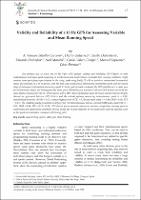Please use this identifier to cite or link to this item:
https://repositorio.usj.es/handle/123456789/271
| Title: | Validity and Reliability of a 10 Hz GPS for Assessing Variable and Mean Running Speed |
| Authors: | Bataller-Cervero, Ana Vanessa


Gutiérrez, Héctor 
DeRenteria, J. Piedrafita, Eduardo 
Marcén, Noel 
Valero-Campo, Carlos 
Lapuente, Manuel Berzosa Sánchez, César 

|
| Keywords: | Speed testing; Sprint; Radar gun; Photo training; Global positioning systems; Distance; Acceleration; Perfomance; Velocity; Units |
| Issue Date: | Jun-2019 |
| Publisher: | SCIENDO, DE GRUYTER POLAND SP Z O O, BOGUMILA ZUGA 32A STR, 01-811 WARSAW, POLAND |
| Citation: | Journal of Human Kinetics volume 67/2019, 17-24 DOI: 10.2478/hukin-2018-0084 17 Section I – Kinesiology |
| Abstract: | Our purpose was to assess the 10 Hz Viper GPS devices’ validity and reliability (STATSport) in both instantaneous and mean speed measuring in accelerations and decelerations in straight-line running conditions. Eight amateur team sport players participated in the study, performing firstly 21 x 40 m sprints at submaximal incremental speed, and secondly 21 x 40 m sprints, with the first stage consisting of submaximal incremental speed, and the second stage of subsequent submaximal decreasing speed. Criteria systems used to evaluate the GPS validity were a radar gun for instantaneous speed, and timing-gates for mean speed. Reliability was measured with two GPS devices carried by the same athlete, running 10 x (20 m + 20 m) sprints with a 180º change of direction and a 10 s inter-set rest interval. Results showed an agreement between GPS devices and the criteria systems measuring instantaneous speed (r = 0.98; standardized mean bias (SMB) = -0.07; standard typical error (STE) = 0.22) and mean speed (r = 0.99; SMB = 0.38; STE = 0.17). The reliability study presented a nearly perfect correlation between devices, a trivial SMB and a small STE (r = 0.97; SMB = 0.04; STE = 0.23). 10 Hz GPS devices are an adequate solution to monitor straight-line running speed in acceleration and deceleration conditions, but we would like to draw attention to the small errors and bias detected, such as the speed overestimation compared with timing gates. |
| URI: | https://repositorio.usj.es/handle/123456789/271 |
| ISSN: | 1681-7230 |
| Appears in Collections: | Artículos de revistas |
Files in This Item:
| File | Description | Size | Format | |
|---|---|---|---|---|
| [18997562 - Journal of Human Kinetics] Validity and Reliability of a 10 Hz GPS for Assessing Variable and Mean Running Speed.pdf | 310,05 kB | Adobe PDF |  View/Open |
This item is licensed under a Creative Commons License

